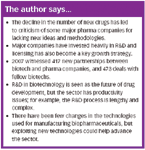Building on the promise of biotech
Pharmaceutical Technology Europe
The productivity of the pharma industry has been declining for several years. Could biotechnology reinvigorate drug development?
In recent years, the pharmaceutical industry has struggled to maintain a high level of productivity. In the late 1990s, it was suggested that for the industry to maintain even a modest growth rate, companies would need to triple the number of new molecular entities (NMEs) launched annually.1,2 Judging by media releases from top 10 companies around this time period, such targets appeared eminently achievable.3,4 However, these public statements were primarily designed to impress the financial sector and meet shareholder expectations.

Faiz Kermani
In the current economic climate, many companies are being forced to be more realistic and admit that their original targets were not achievable. Financial analyses show that the global pharmaceutical industry is now investing twice as much in R&D as it was 10 years ago to generate two-fifths of the medicines it previously produced.2 Furthermore, in 2007, FDA approvals were at their lowest level for 5 years, with only 17 NMEs gaining approval in the US.5 In addition, FDA approved 65 original new drug applications (NDAs) in 2007, the fewest since 1999.5
Declining new drug output has led to criticism of some of the major pharmaceutical companies for lacking new ideas and methodologies. Critics assert that the larger companies are producing too many 'metoo' drugs that are similar to each other and offer little clinical advantage compared with those already available on the global market. Major companies highlight their commitment to innovation by citing their heavy investment in R&D, but this has often not centred on inhouse efforts.
In fact, licensing has become a key growth strategy for the top 20 global pharmaceutical companies, with a number of them openly stating it as a core strategy.6 However, a heavy reliance on licensingin while reducing investment in internal R&D may cause problems for companies. In one industry survey, respondents suggested that licensingin to fill a productivity gap was risky unless a company had sufficient inhouse R&D expertise to assess the compound's potential. In addition, licensing is a hugely competitive field and companies that have built up the widest network will have access to the most promising, laterstage compounds. In contrast, those companies with fewer partnering opportunities may be forced to opt for riskier earlystage compounds.
Exploiting biotech
With traditional R&D approaches failing to live up to expectations in terms of producing new drugs, many have looked to biotechnology to reinvigorate drug development and provide recognizable medical advances. The number of biotech compounds has been increasing steadily during the last 20 years, and most of these focus on difficult disease targets for underserved medical conditions.
Since its emergence in the 1970s, recombinant DNA technology has been used to develop a number of therapeutic proteins, including antibodies, cytokines, hormones and vaccines for tackling and diagnosing a range of disorders. In 2008, the Pharmaceutical Research and Manufacturers of America (PhRMA) reported that there were more than 630 biotech drug products and vaccines in clinical trials targeting more than 200 diseases, including various cancers, Alzheimer's disease, cardiovascular disease, diabetes, multiple sclerosis (MS), AIDS and arthritis. The clinical impact that the current generation of biotech products have had in areas such as cancer and MS illustrates the potential biotechnology has to tackle diseases. In addition, biotechnology is at the heart of many medical diagnostic tests that provide the results needed to optimize drug treatment.

The author says...
From a general perspective, the US biotech industry is the most successful in the world and is likely to maintain this leading position for a while. This is because the US has been much more proactive than other countries in encouraging its biotech sector; for example, in 2003, the US House of Representatives introduced the Biotechnology Future Investment Expansion (BIOFIX) Act (H.R. 2968), a piece of legislation designed to change the US tax code to encourage further investment and innovation in the biotech industry. In Europe, the sector is much further behind in achieving such recognition at a regional level. Some believe that the bureaucratic political set-up of the EU is not always conducive for effective biotech legislation and that individual European countries may do better by implementing national policies.
In 2006, US biotech companies spent $27.1 billion (€20.9 billion) on R&D and accounted for more than 70% of global biotech product revenues.7 Moreover, the number of US biotech companies is increasing and there are now close to 1500 biotech companies employing 180000 people. Although the top five US biotech companies are major manufacturers in their own right, most companies remain small and look for partnerships with larger companies and venture capital for survival.
The biotech industry generates most of its revenue from licensing to major pharmaceutical companies. Collaborations between small biotech companies and larger drug development organizations, such as pharmaceutical companies, can be mutually beneficial. Under such agreements, smaller companies can gain financing to continue their R&D programmes, while the bigger company will supplement its new drug pipeline with an innovative product. The future is likely to see a continuation of this symbiotic relationship. In 2007, there were 417 new partnerships between biotech and pharmaceutical companies, and 473 deals with fellow biotech companies.7
The field of biotech drug development shows no sign of slowing down and is becoming increasingly competitive. Since 2005, biotech drugs have represented 22% of the NME output of the industry and now account for a quarter of total R&D investment.8 Current annual worldwide recombinant product sales are approximately $70 billion (€54 billion).9 In 2007, biotech drug sales grew by 12.5% — twice as fast as the pharmaceutical market.10
Although biotech R&D is seen as the future of drug development, the field has its own productivity issues that must be addressed. Given the nature of the diseases that biotech drugs are being developed for, the R&D process is inevitably lengthy and complex. The difficulty for companies involved in biotech research is that as the R&D process lengthens, so does the cost. This creates considerable pressures in the current tough economic climate, although there appears to be no slow down in major companies seeking biotech partners. Companies are looking at all areas that will give themselves an advantage to launch their biotech drugs in the market. Any improvements to the R&D process are of interest to a range of companies, as both major pharmaceutical companies and smaller specialized firms now develop and market biopharmaceuticals.
In attempting to reduce the risk associated with biotech drug development, companies have been analysing the time, resources, expense and expertise that they can allocate. Because of such efforts during the 1980s and 1990s, companies improved their success rates for recombinant protein (rDNA) therapeutics. The Tufts Center for Drug Development (CSDD) found that the overall success rate for a 1990–1997 cohort of rDNA therapeutics entering clinical trials during was 35% compared with only 26% for a 1980–1997 cohort.11
Yet despite these improvements, CSDD identified efficient manufacturing as one of the core areas to be addressed if further advances were to be made in biotech success rates.11 For example, despite the high level of R&D activity in the sector, there has been little basic change in the technologies used for commercial-scale manufacture of biopharmaceutical products since the 1970s.9 Most current products are being manufactured by old, familiar technologies — primarily using E. coli, Chinese Hamster Ovary cells and Saccharomyces cerevisiae as hosts. Therefore, an opportunity for the future is for biotech companies to exploit new platform technologies. Many newer technologies offer the advantage of speed, including much shorter times to go from gene to transformed host cell line/organism, to commercial-scale manufacture.9 This allows companies to produce the same or higher amounts of products in much shorter time periods.
Outlook
An analysis of the trends during the past decade reveals a clear decline in R&D innovation by pharmaceutical companies. Biotech drug development is a way for companies to improve this situation, but the field is highly complex, expensive and increasingly competitive. Despite the current economic environment, companies will need to make heavy investment in new technologies to ensure they benefit from the promise biotech R&D offers and avoid the decline that has been experienced in traditional pharmaceutical R&D.
References
1. F. Kermani and G. Findlay, The Application of Drug Delivery Systems (Centre for Medicines Research International, UK, 2000).
2. Pharma 2020: The vision (PricewaterhouseCoopers, 2007).
3. PR Newswire, "Pfizer Expects to Launch Three New Drugs in 1998, Company Tells Wall Street" (1999). www.prnewswire.com
4. AstraZeneca, "AstraZeneca Progresses Key Products And Aims To Double Product Portfolio Value Every Five Years" (1999). www.astrazeneca.com
5. J. Schmidt, USA Today (February, 2008).
6. J. Mittra, Changing Strategies of Big Pharma (2007). www.genomicsnetwork.ac.uk
7. BIO, "Biotechnology Industry Facts" (2008). www.bio.org
8. CMR International, The CMR International 2007 Pharmaceutical R&D Factbook (UK, 2007).
9. R. Rader, Biopharmaceutical Expression Systems and Genetic Engineering Technologies (BioPlan Associates, Inc., MD, USA, 2008).
10. M. Martino, "The biotech market share report" (2008). www.fiercebiotech.com
11. Anon, Tufts Center for the Study of Drug Development Impact Report, 7(2) (March/April 2005). http://csdd.tufts.edu

PacBio Chosen as Tech Partner for Global Alzheimer’s Disease Research Project
April 23rd 2025The project, the North African Dementia Registry, will unite multiple entities for the purpose of developing a comprehensive dataset to advance the research community’s understanding of Alzheimer’s disease and other dementias in diverse populations.
Drug Solutions Podcast: Applying Appropriate Analytics to Drug Development
March 26th 2024In this episode of the Drug Solutions Podcast, Jan Bekker, Vice President of Business Development, Commercial and Technical Operations at BioCina, discusses the latest analytical tools and their applications in the drug development market.